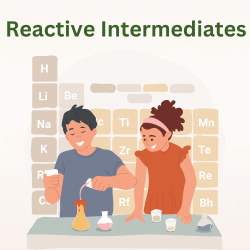Introduction to Free Radicals- History
In the 1700s, the term radical, Latin for root, was used for any group that remained rooted or unchanged in a chemical reaction. So, the -CH3 in CH3-OH undergoing chemical transformation to CH3-Cl was radical.
Therefore, a substituent or a functional group free from a chemical transformation was called a ‘free radical.’
However, when Moses Gomberg, in 1900, discovered a reactive specie, a triphenylmethyl radical (Ph3C.), that reacted unlike any hydrocarbon or a cation or anion that the meaning of free radical underwent a significant change. The looser definition became - any transient or chemically unstable specie (atom, molecule, or ion).
Today the term radical and free radical are used interchangeably.
What is a Free Radical?
Free radicals are highly reactive, electron-deficient species (atom, molecule, or ion) with at least one unpaired electron, denoted officially with a middle dot (.) beside the atom.

Most radicals are unstable and have a very short life span, and to find stability, they quickly dimerize, forming an additive product (adduct) by linking two radical specie.

In organic chemistry, the reactions involving free radicals are usually carbon centered.
A carbon-centered free radical is a neutral, electron-deficient carbon atom. The electron deficiency is due to its lack of one electron from ideal eight in the valence shell of carbon by covalent bonding.
The carbon radical with its single unpaired electron function as a reactive intermediate in many organic chemistry reactions.

Types of Carbon-Centered Radicals
Based on the number of alkyl substituents on the carbon, carbon-free radicals are of three types: Primary, secondary, and tertiary.
The primary (10) carbon-centered radical has one alkyl substituent, the secondary (20) carbon-centered radical has two alkyl substituents, and the tertiary (3o) carbon-centered radical has three alkyl substituents. The carbon atom with no alkyl substituents is called methyl carbon-centered radical.

Structure of Carbon-Centered Free Radical
A carbon atom always wants to share its four electrons by covalent bond formation with other atoms to get a total of eight electrons and four bonds.
However, when it loses one electron, it loses its octet stability. It becomes a highly reactive radical with only seven valence electrons, waiting to acquire the coveted eighth.
The carbon lost not only one electron but also a covalent bond and is now down to three. This leads to a change in hybridization, the event that earlier led the parent carbon to form four identical bonds, from sp3 to sp2.

The alkyl carbon radical is sp2 hybridized, the substituents are coplanar, and the bond angle between them is 120o. The lone electron is housed in the 2 p-orbital, perpendicular to the other sp2 hybrid orbitals.

